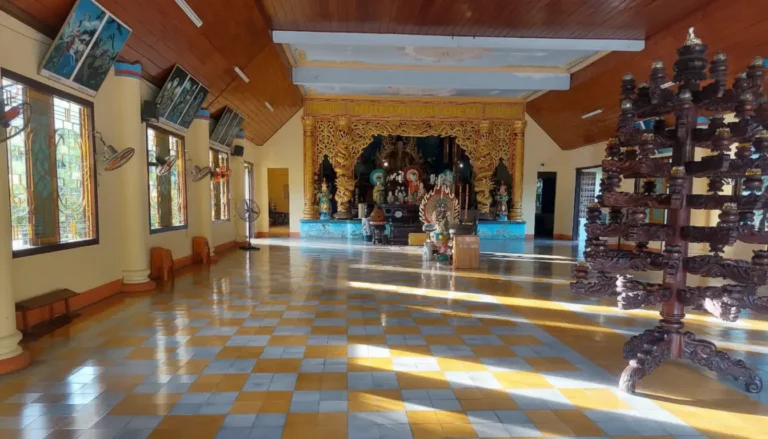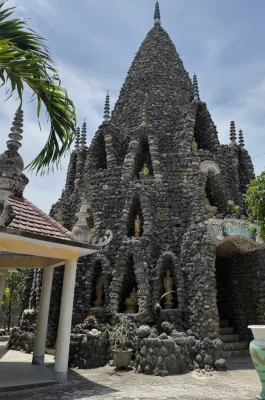The Tu Van Pagoda (Chùa Từ Vân) offers an incredibly unique spiritual and architectural experience in Khánh Hòa Province, standing out from traditional Vietnamese temples. Commonly known as the “Shell Pagoda” (Chùa Ốc) or “Coral Pagoda” (Chùa San Hô), it attracts visitors not only for worship but also to marvel at its one-of-a-kind, handmade structures that capture the essence of the sea.
History and Unique Coastal Architecture
The pagoda began construction in 1968, serving as a place of worship and reflection for monks. However, its distinctive look originated in the 1990s when the resident monks began collecting vast quantities of seashells, clams, and coral from the nearby coast. They then used these materials to design and construct unique spiritual structures by hand.
Bao Tich Tower: This is the pagoda’s central and most famous feature. Standing about 39 $\text{m}$ tall, it holds the record for the tallest Bao Tich tower in Vietnam. The tower’s exterior and interior walls feature intricate mosaic patterns meticulously created using thousands of shells and coral pieces. It has eight doors, symbolizing the Bat Chanh Dao (The Noble Eightfold Path) to enlightenment.
The Seashell Boat: Near the entrance, a three-story, shell-decorated boat (Thuyền Bát Nhã) represents the vessel of wisdom carrying living beings across the sea of suffering to the land of the Buddha.

The 18 Levels of Hell (18 Tầng Địa Ngục)
For many visitors, the highlight is the mysterious and thought-provoking passage known as the “18 Levels of Hell” (18 Tầng Địa Ngục).
Moral Journey: Monks constructed this long, dark, and winding tunnel using coral rock, leading visitors through a symbolic journey of Buddhist morality.
Depicting Sins: The tunnel features small, detailed dioramas and scenes at various gates, illustrating the tortures and punishments that sinners must undergo in Buddhist hell, based on the misdeeds committed during their lives.
A Unique Experience: The immersive, half-dark environment encourages visitors to reflect deeply on the consequences of their actions before they emerge through an exit designed to look like the mouth of a dragon, symbolizing the return to the earthly world.

Visitor Information and Cultural Notes
The pagoda is situated in Cam Ranh City, making it an excellent stop for those traveling between Nha Trang and the south.
| Information Point | Detail | Note |
|---|---|---|
| Location | Cam Ranh City, Khánh Hòa Province. | Approximately 60 km from Nha Trang City. |
| Admission Fee | Free | The temple welcomes visitors for sightseeing and worship. |
| Opening Hours | Generally open throughout the day. | It is best to visit during daylight hours to appreciate the architecture. |
| Contact Phone | No public number is widely available for tourism inquiries. | The pagoda focuses on its spiritual mission. |
| Local Practice | The head monk traditionally does not accept monetary donations (Phước Sương), instead relying on the cultivation of medicinal herbs to sustain the temple. | Visitors should maintain respectful decorum and dress modestly. |
The Tu Van Pagoda provides a peaceful contrast to the bustling city life of Nha Trang, offering a chance to witness an unparalleled example of devout, hand-crafted folk architecture.









